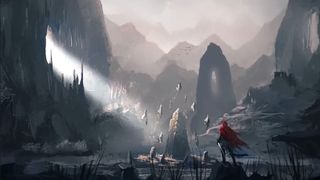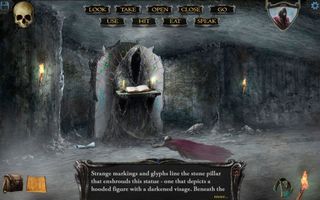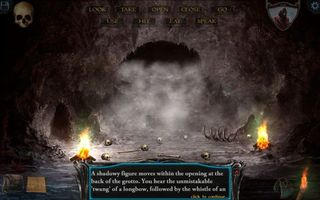Shadowgate interview: crowdfunding, art style, and making a classic game just modern enough

I really wanted to fight wizards as an eight-year-old. I watched my older brother play Dungeons & Dragons with his friends, but I was far too young to join them as they adventured through castles and battled dragons. So when my brother sat me down in front of the NES version of Shadowgate, it felt like I was finally getting an adventure of my own. A terrifying, difficult adventure, where one wrong click meant instant death.
Twenty-five years later, the original developers are bringing Shadowgate back, this time to Steam. Developer Zojoi has reimagined what standing in front of the living castle should feel like, adding a (slightly) modern interface to the same punishing adventure gameplay of the original. Ahead of its summer release, I spoke to design director Karl Roelofs about what makes a modern Shadowgate, and why the team used illustrations instead of 3D models.
PC Gamer : Shadowgate is a defining game from my childhood. What made you guys want to bring it back into the modern age?
Karl Roelofs : Dave Marsh [and I] co-created Shadowgate way back in the day and I've known him since high school. We've been best friends ever since and we always talked about visiting Shadowgate again. We think the story really didn't get its due. We've always had more stuff that we wanted to share with people.

Then along comes Kickstarter and the major success of the Double Fine game and Dave and I just said, "Well, why not? Why not us? Why not Shadowgate? It's a popular game. Fans throughout the years have told us how much they really love the game, how much it scared them on the NES when they were playing it there."
PCG : The original game used an interface that replicated another desktop on your screen, which is something that modern game design wouldn't really do. Can you talk a little bit about some of the steps that you guys took to modernize the Shadowgate experience?
Roelofs : Well, we decided early on to embrace the command system of the original Shadowgate game, meaning you have button commands that you can click so you can interact with objects on the screen. We went around and around trying to figure out a different way to really make that work within the game, and at the end of the day, we just felt that it works with buttons. Yes, it's kind of retro, but it works and the play speaks for itself because you get interaction, you get a notebook thing of all the objects. We left that command system on its own with a few updates and modern game tab, like key binds and shortcuts and lots of things to make it easier for people who are more experienced with button pushing and things of that nature.
PC Gamer Newsletter
Sign up to get the best content of the week, and great gaming deals, as picked by the editors.
The game is full screen, it's not in a window [like the original game]. We got to do cool, big graphics. We added a bunch of ambient animation. We also decided that we wanted to add a map to the game, because the original game had various mechanisms to move from room to room, so we felt why not do a map? People play these adventure games and they map it out themselves, so let's make our own map.

There's a couple other cool things that we've embraced as well, which I'll keep a little bit of a secret. One cool think we got to do is add achievements. That's just loads of fun, throwing a bunch of achievements in there, getting all the torches and lighting all the torches, just stuff like that. That's just a cool thing to add.
PCG : Do you look at the achievements as you're designing the game and think, "Well, here's an interesting thing that we can throw in?" Or is it all done after the fact where you have to retrofit the way those achievements are going to work with a game you've already designed?
Roelofs : A little bit of both, to be totally honest. Early on, we knew we wanted achievements. Each room is scripted with all of its interactions. I had the rooms fully scripted about three quarters of the way through when we really knuckled down on the achievements and said, "We've got to add achievements, that'll be cool." So, I kind of retro fitted a few. At last check, we're at 45 achievements and who knows? Maybe we'll have a few more.
PCG : How big is the team working on the game?
Roelofs : We have three programmers, an artist from Russia who's contracted out, and Rich Douglas in Texas who does the sound design. We have three interns that are here in Charlottesville, so there's 8 to 10 of us.
PCG : A pretty small team. I'm going to guess that the original Shadowgate team was pretty small too.

Roelofs : It was, yeah, probably about 10 or 12 all told. It's almost a throw back in a lot of ways to doing it back in those late '80's where you had a handful of people and everybody's wearing so many different hats and just knuckling down and doing it.
PCG : You can probably target this game at the retro mindset people who remember the old Shadowgate game back in the day much so more so than you can trying to win people over and show them what an adventure game is like. Does that sound right?
Roelofs : I hear what you're saying and that's a reasonable line of thinking, but we really do feel that we can hit younger gamers again. When Shadowgate came out on the NES, there were no games like it. That was a new game and a lot people who were real young and had the NES all of a sudden discovered the game and said, "Hey this is pretty cool." So, we feel that we can reach out to the new gamer, the younger gamer now, that market and try to give them an alternative.
PCG : How are you specifically going to target the game to that new audience?
Roelofs : Well, the art style. We tried to go dark and visceral with the art style, trying to make it something that I think will appeal to both a young and older crowd. It's a very unique look and that's what I felt Shadowgate had on the Mac and the NES. I feel that we can reintroduce just the aspect of interacting with the world of Shadowgate because that's really what we're trying to build is more of a world and we're limited but we're just trying to have as much interaction as we can.

PCG : How are you limited?
Roelofs : We chose not to do 3D—for multiple reasons. People would look at that as potentially something that's limiting. I don't think it is, because I think the story driven single pane play style is unique in and of itself, because you can look at the screen and hunt around and do things on screen where the 3D thing, it's all motion and movement and you're just going all over the place. This is a little bit more of a thinking game on top of the adventure. That would be considered limiting, I think.
PCG : Will this Shadowgate be as difficult as the original? Or are you making it easier for the new audience?
Roelofs : It's both. We have three levels of difficulty. The hard level, the highest one, is going to be relentless. You've got to manage your torches, you've got to be careful what you do. We have a medium level which takes the hard level puzzles and it makes a little more forgiving—torches may last a little longer. Some puzzles may not have exactly all the steps that are in the hard one, or they may be slightly different, but still the same in an essence. Then for the easy level, we don't want to hold any body's hand, but it's going to be easier. We want you to enjoy your experience, but we also look forward to killing you in our game. That's another thing that we embrace in this game. If you want to do something stupid, go for it, see what happens.
PCG : I remember all the different stupid things I did in the original game and how I'd be totally punished for it.
Roelofs : Exactly. Like I said, there'll be difficulty levels so you're still going to punished, but maybe not as much.

Most Popular

